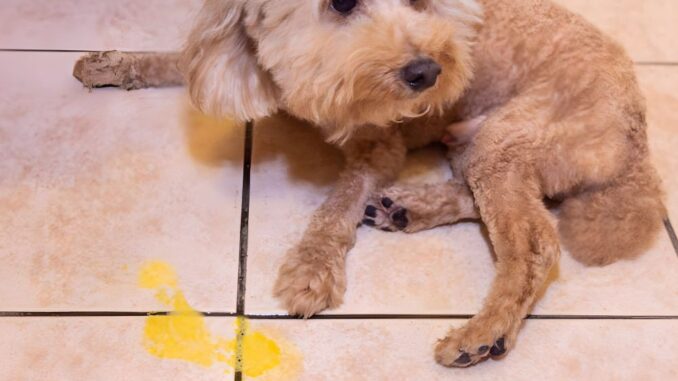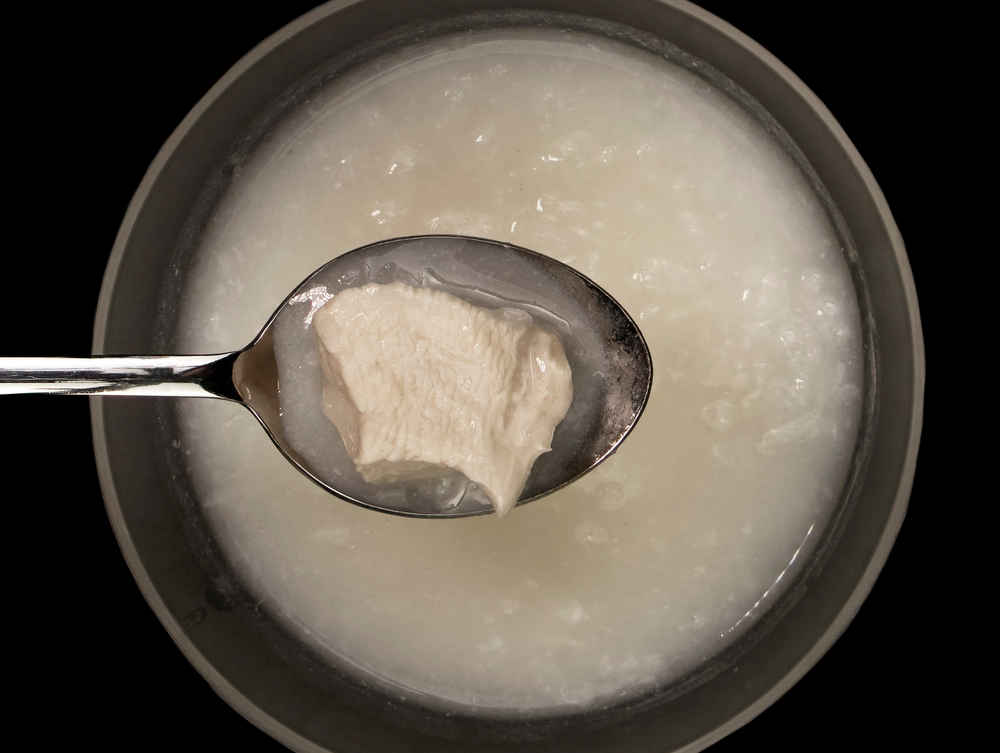
This article was updated on January 31st, 2024
Senior dogs vomiting a yellow-colored fluid might have bilious vomiting syndrome. In elderly dogs, it is caused when your dog vomits a few times a week. This is often seen early in the morning when your dog first wakes up and has an empty stomach.
Many dogs who have mild cases of bilious vomiting can easily be cured with at-home treatment such as a bland diet, small frequent meals, and medications to help decrease stomach acid. In this article, we will review the 5 best home remedies, and when to call your vet for help!
5 steps you can take at home to help your dog [home remedies]
Many dogs can easily be treated with lifestyle modifications. Feeding a bland diet and avoiding high-fat diets and human foods can often help treat bilious vomiting syndrome in your older dog. These are some at-home remedies that you can try to help treat this condition before seeing your vet:
1. Offer a bland diet.
Bland diet such as chicken and rice can help keep your dog’s stomach calm.

If you don’t have chicken or rice, you can read our article about the best bland diets for dogs to discover other options. You can also purchase a sensitive stomach diet at the pet store to feed your dog. Many dogs can have recurring issues that require a specialized diet for their entire life. Cooking at home may not provide all the necessary nutrients for a balanced diet.
2. Feed small frequent meals.
Many times, dogs with bilious vomiting syndrome will vomit more often when their stomach is empty. By feeding a small meal frequently will help keep their stomachs full of food. Usually feeding your dogs every 3 to 4 hours will help treat bilious vomiting syndrome.
3. Feed your dog right before they go to bed.
This is often the only change that dogs need. This helps ensure that they do not have a prolonged period of time without any food in their stomach.
4. Give a gastric acid reducer.
Over-the-counter medications intended to decrease gastric acid production will help treat bilious vomiting syndrome. Commonly used medications are Pepcid, or Prilosec. However, it is important to talk to your vet before giving your dog any medications (even over the counter medications). Some medications may not be good for your dog depending on their health profiles.
A study published in 2016 shows that most dogs quickly improve with lifestyle modifications and gastric acid reducers. Many times older dogs have very good success with these treatments as long as there are no underlying issues or other diseases that they also are dealing with.
5. Avoid human food and dog treats.
Some dogs have very sensitive stomachs, and any human food or high-fat dog treats can cause them to have GI issues.
Our patients sometimes ask us: are there herbal remedies for dogs vomiting yellow bile? You can give your dog herbs such as catnip, fennel, chamomile, peppermint, and ginger to help decrease vomiting and nausea in dogs.
Finally – see your vet. For dogs who continue to vomit, it would be best for them to see your veterinarian. Your vet will be able to prescribe medication to help decrease their vomiting and calm their stomach. There are also prescription diets that your vet can recommend for you to treat bilious vomiting syndrome.
You should not try home remedies if your dog is lethargic, vomits blood or shows other signs of illness
Sometimes at home treatment for bilious vomiting syndrome should not be tried. If your dog is very lethargic, vomiting blood, dehydrated, or also having diarrhea, it is best to not try any at-home treatments as your dog needs more intense and immediate veterinary care. Delaying veterinary care could have a very negative impact on your dog’s health.
“It is important to take your dog to see a vet, even if home remedies provide temporary relief, as a vet can accurately diagnose the underlying condition causing the vomiting and provide appropriate treatment.”
When to try home remedies / when to see the vet
If your dog vomits yellow bile just once and is otherwise acting okay there is nothing to be worried about. Some dogs will eat something that they should not have such as a bug, or human food. This can cause them to vomit yellow bile. However, Dr. Ochoa explains more severe cases that need a vet’s intervention:
“Some dogs will also continue to vomit and become lethargic. If this happens, your dog should see a vet right away. While bilious vomiting syndrome in older dogs is not a life-threatening condition, the condition can cause other issues to develop such as pancreatitis and GI ulceration leading to continued vomiting, diarrhea, and blood in the stool or vomit. These can become life-threatening if left untreated.”
Signs that your dog needs to see their veterinarian
Most dogs with bilious vomiting syndrome are only vomiting occasionally and are otherwise eating, drinking, and acting perfectly normal. However, you should see your vet if any of the following applies:
- your dog continues to vomit and does not improve after 24 hours
- your dog begins to also have diarrhea or other signs of illness
- your dog vomits more than 3 times in one day
The longer you prolong your vet visit the more likely that they will need more intense and expensive medical treatment. Some dogs will benefit from IV fluids and prescription medication to help decrease their vomiting.
Common causes of yellow vomiting / bilious vomiting syndrome in elderly dogs
These are some of the most common reasons for your dog to be vomiting yellow bile.
1. Pancreatitis: Pancreatitis is an inflammation of your dog’s pancreas. This is a common condition that will cause your dog to vomit and have diarrhea. Pancreatitis is caused by your dog eating a high fatty meal.
How do you know if your dog has pancreatitis? Your dog will also have a very painful stomach and not eat. Most common symptoms include vomiting, abdominal pain, and loss of appetite.
Treatment: Pancreatitis can be treated but in severe cases can be fatal. Sometimes your dog will need to see your vet for IV fluids and injectable medication for them to recover. For very mild cases of pancreatitis, you can try at-home treatment of a bland diet but if your dog does not stop vomiting and eating after 24 hours, they will need to see your vet. The cost of this workup and treatment at your vet can be $500 to $1500+ depending on the severity of your dog’s condition. Learn about the best ways to care for a dog with pancreatitis.
2. Gastroenteritis: Gastroenteritis is inflammation of the intestines. This can commonly cause your dog to have yellow vomiting, in particular, once the stomach is empty.
How do you know if your dog has gastroenteritis? Dogs with gastroenteritis will often have several episodes of vomiting and diarrhea, and frequent bowel movements. It is usually caused when your dog eats something that they should not eat.
Treatment: In mild cases, you can offer a bland diet and probiotics. In more severe cases your dog will need to see your vet. They will be able to prescribe medications and IV fluids to help them fully recover. The average cost of this treatment can be $500 to $1500+ depending on the severity of your dog’s condition.
3. Liver or kidney disease: If your dog is having liver or kidney issues, they can commonly vomit yellow bile.
How do you know if your dog has liver or kidney disease: Other common symptoms include lack of appetite, weight loss, vomiting and diarrhea. Most dogs will need to see your veterinarian for treatment.
Treatment: Your vet will want to run bloodwork to see how severe the disease is and start a treatment plan. The cost of treatment of liver and kidney diseases is $500 to $2000+ depending on what treatment is needed.
4. Dietary indiscretion: Dietary indiscretion is caused when your dog eats something that they should not have such as human food. Many dogs will have yellow vomit with this but can fully recover without any treatment in just a few days. If your dog continues to vomit, it would be best that they see your vet right away. Cost will depend on how severe your dog’s signs are and can range from $200 to $500+
5. Toxin exposure: There are many chemicals, plants and other environmental elements that can be toxic to your dog. This can cause your dog to vomit yellow bile. Most of these dogs will also be very lethargic and sick. If you think that your dog has eaten something that is toxic, it is best for them to see a vet right away. Most likely they will need bloodwork and IV fluids to help treat these toxicities. The average cost of toxicity treatment is $500 to $1,000,
6. Gastric Foreign Body obstruction: Some dogs will eat things that they should not like a sock, underwear or toy. These can easily get stuck in their intestines along the way out causing an obstruction. This will also cause your dog to vomit yellow bile. Most dogs will vomit every time that they eat. At first they will still be playful and active but as time goes on they will become more lethargic. If your dog has ate something that they should not have, it is best that they see your vet. They may be able to get them to vomit this back up. If not they will need to go to surgery to remove the object.
How your vet can help
Diagnosing yellow vomiting in senior dogs / bilious vomiting syndrome
Bilious vomiting syndrome is diagnosed by ruling out anything else that can cause your dog to vomit. Many times your vet will want to run blood work, take x-rays or other diagnostic tests to determine the cause of the vomiting.
What is the average cost of treatment?
The cost of treatment can depend on your location and how sick your dog is when you bring them to the vet. For basic treatment, you may spend around $200 to $300 but for more serious conditions requiring your dog to spend the night in the hospital, you may spend over $1,000. Your vet should be able to provide you an estimate for the treatment plan.
There are certain costs for treatment that some people do not consider such as medications that your vet may recommend for prevention or specialized diets.
Is treatment covered by insurance or out of pocket?
The cost of treatment can be covered by pet insurance. If this is the first time this is occurring most insurance will cover the diagnostic tests and treatments. If your dog has a history of this occurring very frequently, your insurance plan may not cover this and you would have to pay out of pocket.
How long does bilious vomiting syndrome last in senior dogs?
Bilious vomiting syndrome usually only lasts a few days and most dogs will quickly recover with simple lifestyle modifications. Dogs with persistent symptoms should see their vet.
Is there a way to prevent an elderly dog from getting bilious vomiting syndrome again?
Prevention is the best way to treat bilious vomiting syndrome. It is best to not offer your dog any human food or fatty dog treats. If your dog has a history of vomiting bile, it would be best to feed them many small meals throughout the day and make sure that they eat a small amount right before they go to bed. You can also offer them gastric acid medication on a regular basis to help prevent them from vomiting.
The best way to prevent your elderly dog from getting bilious vomiting syndrome is by feeding small frequent meals and making sure that they eat right before bed so that they do not go to bed on an empty stomach.
Other FAQs
What does the color of bilious vomiting syndrome in elderly dogs mean?
Dogs will bilious vomiting syndrome will vomit a yellow color vomit. This is the bile that is in your dog’s stomach being vomited back up. When your dog eats bile is released into the stomach to help your dog’s body break down and digest food. When there is not enough food in their stomach, this bile will stay in their stomach causing them to vomit a yellow color.
How serious is bilious vomiting syndrome in elderly dogs?
Mild cases of bilious vomiting syndrome is not a very serious condition. If your dog is vomiting, having diarrhea or is lethargic, this is more of a concern that will need to see a vet right away.
Is an elderly dog vomiting yellow bile an emergency?
If your dog vomits yellow bile just once and is otherwise acting just fine, this is not an emergency. If they continue vomiting or are acting lethargic, it would be best to see a vet.
Disclaimer: This website's content is not a substitute for veterinary care. Always consult with your veterinarian for healthcare decisions. Read More.


Be the first to comment